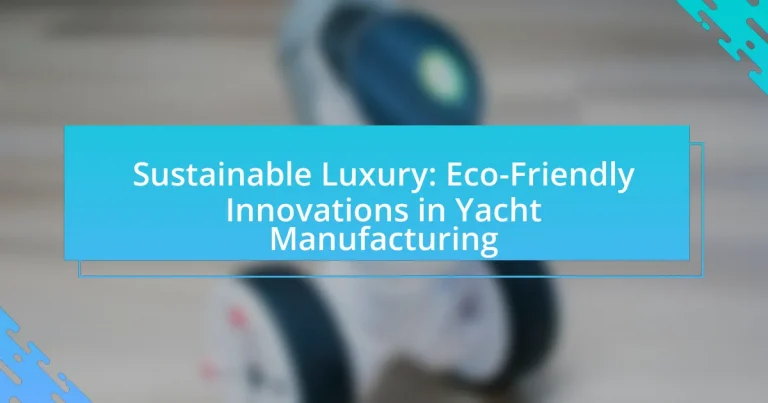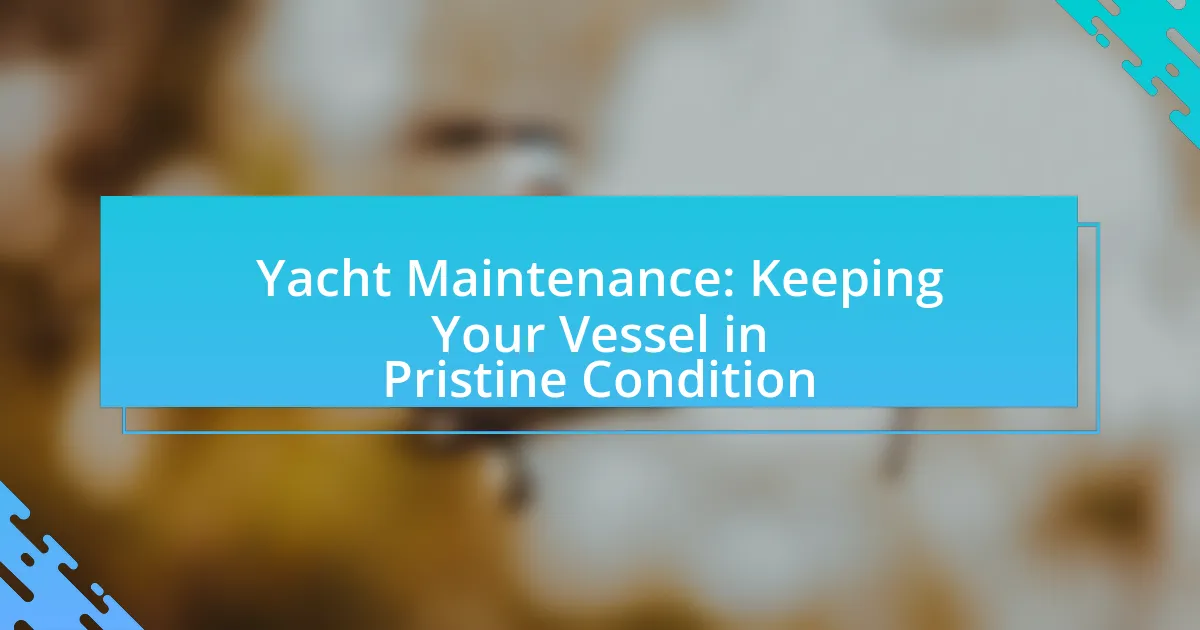Sustainable luxury in yacht manufacturing emphasizes the incorporation of eco-friendly practices and materials in the design and production of luxury yachts. This article explores how sustainability is integrated into yacht design through the use of renewable energy sources, eco-friendly materials, and innovative waste management systems. It highlights the importance of sustainable luxury in addressing environmental concerns, the impact of consumer demand on manufacturing practices, and the advancements in materials and technologies that promote sustainability. Additionally, the article discusses the challenges manufacturers face in adopting sustainable practices and offers guidance for consumers interested in eco-friendly yacht ownership.
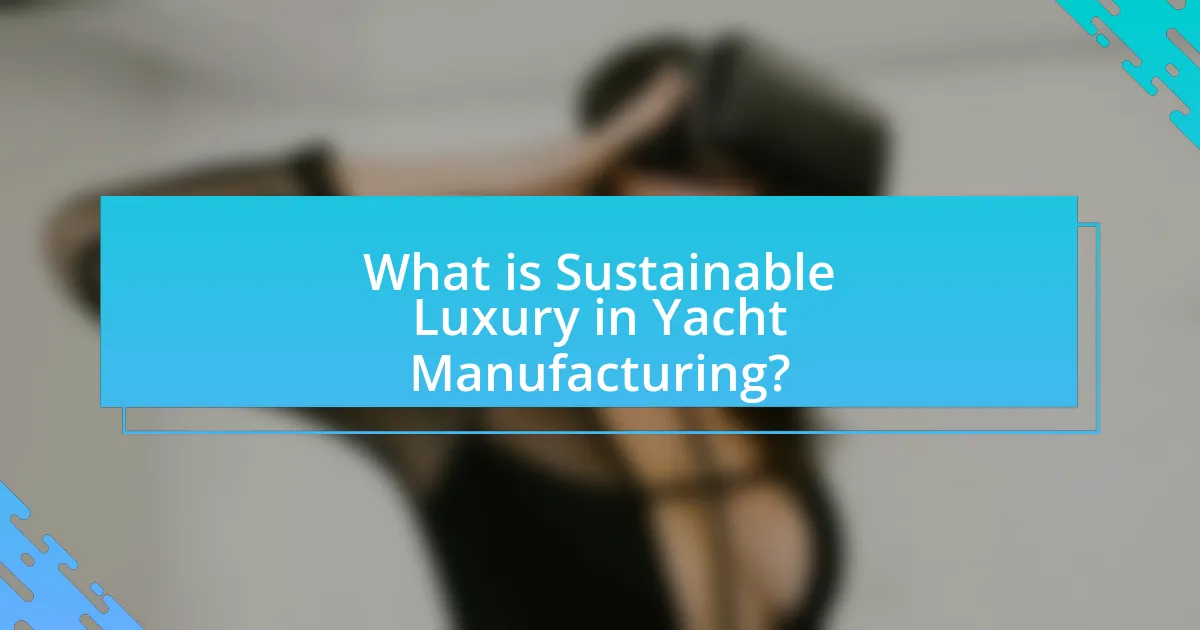
What is Sustainable Luxury in Yacht Manufacturing?
Sustainable luxury in yacht manufacturing refers to the integration of environmentally friendly practices and materials in the design and production of luxury yachts. This approach prioritizes ecological responsibility while maintaining high standards of quality and comfort. For instance, manufacturers are increasingly using renewable energy sources, such as solar panels and wind turbines, to power yachts, thereby reducing carbon footprints. Additionally, sustainable luxury yachts often incorporate eco-friendly materials like recycled aluminum and sustainably sourced wood, which minimize environmental impact. The shift towards sustainable luxury is supported by growing consumer demand for environmentally conscious products, as evidenced by a 2021 report from the Global Sustainable Investment Alliance, which indicated that sustainable investments reached $35.3 trillion globally, reflecting a significant trend towards sustainability in various sectors, including luxury goods.
How does sustainability integrate into luxury yacht design?
Sustainability integrates into luxury yacht design through the use of eco-friendly materials, energy-efficient technologies, and innovative waste management systems. Designers increasingly incorporate sustainable materials such as recycled aluminum and responsibly sourced wood, which reduce environmental impact while maintaining luxury aesthetics. Additionally, advanced technologies like hybrid propulsion systems and solar panels enhance energy efficiency, allowing yachts to operate with lower emissions. Furthermore, effective waste management practices, including onboard recycling and water purification systems, minimize the ecological footprint of luxury yachts. These approaches reflect a growing commitment within the industry to balance luxury with environmental responsibility.
What materials are considered eco-friendly in yacht manufacturing?
Eco-friendly materials in yacht manufacturing include bamboo, recycled aluminum, and bio-based composites. Bamboo is a rapidly renewable resource that offers strength and durability, making it suitable for various yacht components. Recycled aluminum reduces the environmental impact associated with mining and processing new aluminum, while bio-based composites, derived from natural fibers and resins, provide lightweight and sustainable alternatives to traditional materials. These materials contribute to reducing the carbon footprint of yacht production and promote sustainability in the marine industry.
How do design principles change when focusing on sustainability?
Design principles shift significantly when focusing on sustainability by prioritizing eco-friendly materials, energy efficiency, and lifecycle impact. In yacht manufacturing, this means selecting renewable resources, such as sustainably sourced wood or recycled metals, to minimize environmental harm. Additionally, designs are increasingly incorporating energy-efficient technologies, like solar panels and hybrid propulsion systems, which reduce fuel consumption and emissions. Research indicates that sustainable design can lead to a 30% reduction in energy use during production and operation, demonstrating the tangible benefits of these principles in practice.
Why is sustainable luxury important in the yacht industry?
Sustainable luxury is important in the yacht industry because it addresses environmental concerns while meeting the demands of affluent consumers for eco-friendly options. The yacht industry significantly impacts marine ecosystems through emissions and resource consumption; therefore, adopting sustainable practices helps mitigate these effects. For instance, the use of renewable energy sources, such as solar panels and hybrid propulsion systems, reduces carbon footprints and promotes energy efficiency. According to a report by the International Maritime Organization, the shipping industry, including yachts, contributes approximately 2.5% of global greenhouse gas emissions, highlighting the need for sustainable innovations. By prioritizing sustainability, the yacht industry can enhance its reputation, attract environmentally conscious buyers, and contribute to the preservation of marine environments.
What environmental impacts does traditional yacht manufacturing have?
Traditional yacht manufacturing has significant environmental impacts, primarily due to the use of non-renewable materials and energy-intensive processes. The production of yachts often involves fiberglass, resins, and metals, which contribute to pollution and resource depletion. For instance, the manufacturing process can release volatile organic compounds (VOCs) into the atmosphere, leading to air quality degradation. Additionally, the disposal of yacht materials at the end of their lifecycle can result in marine pollution, as many components are not biodegradable. According to a study by the International Maritime Organization, shipbuilding and repair activities contribute to approximately 10% of global ship emissions, highlighting the industry’s substantial carbon footprint.
How does consumer demand influence sustainable practices in yacht manufacturing?
Consumer demand significantly influences sustainable practices in yacht manufacturing by driving manufacturers to adopt eco-friendly materials and technologies. As affluent consumers increasingly prioritize sustainability, yacht builders respond by integrating renewable energy systems, such as solar panels and hybrid propulsion, into their designs. For instance, a 2021 report by the International Council on Clean Transportation highlighted that 70% of luxury yacht buyers consider environmental impact when making purchasing decisions. This shift in consumer preferences compels manufacturers to innovate and comply with stricter environmental regulations, ultimately leading to a more sustainable industry.
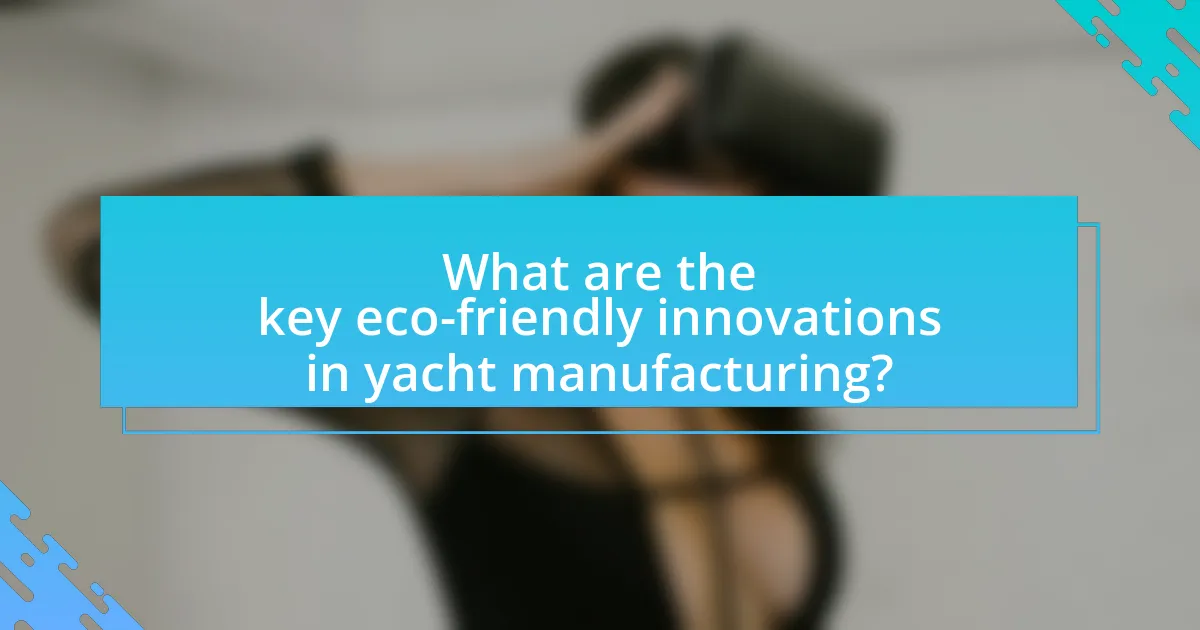
What are the key eco-friendly innovations in yacht manufacturing?
Key eco-friendly innovations in yacht manufacturing include the use of sustainable materials, hybrid propulsion systems, and advanced waste management technologies. Sustainable materials such as recycled aluminum and eco-friendly composites reduce environmental impact during production. Hybrid propulsion systems, which combine traditional engines with electric power, significantly lower emissions and fuel consumption. Advanced waste management technologies, including onboard treatment systems, ensure that waste is processed efficiently, minimizing pollution in marine environments. These innovations collectively contribute to a more sustainable approach in the luxury yacht industry.
How are renewable energy sources utilized in yacht design?
Renewable energy sources are utilized in yacht design primarily through the integration of solar panels, wind turbines, and hybrid propulsion systems. Solar panels are installed on yacht surfaces to harness sunlight, converting it into electricity for onboard systems, thereby reducing reliance on fossil fuels. Wind turbines can be incorporated into the yacht’s design to capture wind energy, further enhancing energy efficiency. Hybrid propulsion systems combine traditional engines with electric motors powered by renewable sources, allowing for reduced emissions and improved fuel efficiency. These innovations not only contribute to sustainability but also align with the growing demand for eco-friendly luxury in the yachting industry.
What types of renewable energy systems are commonly used in yachts?
Commonly used renewable energy systems in yachts include solar panels, wind turbines, and hydro generators. Solar panels convert sunlight into electricity, providing a sustainable power source for onboard systems. Wind turbines harness wind energy to generate electricity, complementing solar power, especially in open waters. Hydro generators utilize the movement of water to produce energy while the yacht is in motion, further enhancing energy efficiency. These systems collectively contribute to reducing reliance on fossil fuels and minimizing environmental impact in yacht manufacturing.
How do these systems enhance the yacht’s performance and sustainability?
These systems enhance the yacht’s performance and sustainability by integrating advanced technologies such as hybrid propulsion, energy-efficient hull designs, and renewable energy sources. Hybrid propulsion systems reduce fuel consumption and emissions, improving overall efficiency; for instance, yachts equipped with hybrid engines can achieve up to 30% lower fuel usage compared to traditional engines. Energy-efficient hull designs minimize drag, allowing for faster speeds with less power, which contributes to reduced environmental impact. Additionally, the incorporation of solar panels and wind turbines enables yachts to harness renewable energy, further decreasing reliance on fossil fuels and promoting sustainability in luxury yachting.
What advancements in materials are shaping sustainable yacht manufacturing?
Advancements in materials shaping sustainable yacht manufacturing include the use of bio-based composites, recycled aluminum, and sustainable wood alternatives. Bio-based composites, made from natural fibers and resins, reduce reliance on petroleum-based products and lower carbon footprints. Recycled aluminum, which can be reused without loss of quality, significantly decreases energy consumption during production compared to virgin aluminum. Additionally, sustainable wood alternatives, such as bamboo and reclaimed timber, provide eco-friendly options that minimize deforestation and promote responsible sourcing. These materials collectively contribute to reducing environmental impact while maintaining performance and aesthetics in yacht design.
What are the benefits of using recycled materials in yacht construction?
Using recycled materials in yacht construction offers significant environmental and economic benefits. Firstly, it reduces the demand for virgin resources, thereby conserving natural materials and minimizing environmental degradation associated with extraction processes. For instance, utilizing recycled aluminum can save up to 95% of the energy required to produce new aluminum from ore. Additionally, incorporating recycled materials can lower production costs, as recycled inputs are often less expensive than new materials. This approach also enhances the yacht’s sustainability profile, appealing to eco-conscious consumers and potentially increasing market value. Furthermore, using recycled materials can contribute to waste reduction, as it diverts materials from landfills, promoting a circular economy within the marine industry.
How do alternative materials compare to traditional yacht building materials?
Alternative materials, such as fiberglass, aluminum, and composite materials, generally offer advantages over traditional yacht building materials like wood and steel in terms of weight, durability, and environmental impact. For instance, fiberglass is lighter than wood, which enhances fuel efficiency and speed, while aluminum provides corrosion resistance and strength without the maintenance issues associated with steel. Additionally, composite materials can be engineered for specific performance characteristics, allowing for greater design flexibility.
Research indicates that using alternative materials can reduce the carbon footprint of yacht manufacturing; for example, a study by the International Maritime Organization found that lightweight materials can lead to a 20% reduction in fuel consumption. This shift towards alternative materials aligns with the growing demand for sustainable luxury in yacht manufacturing, as consumers increasingly prioritize eco-friendly innovations.
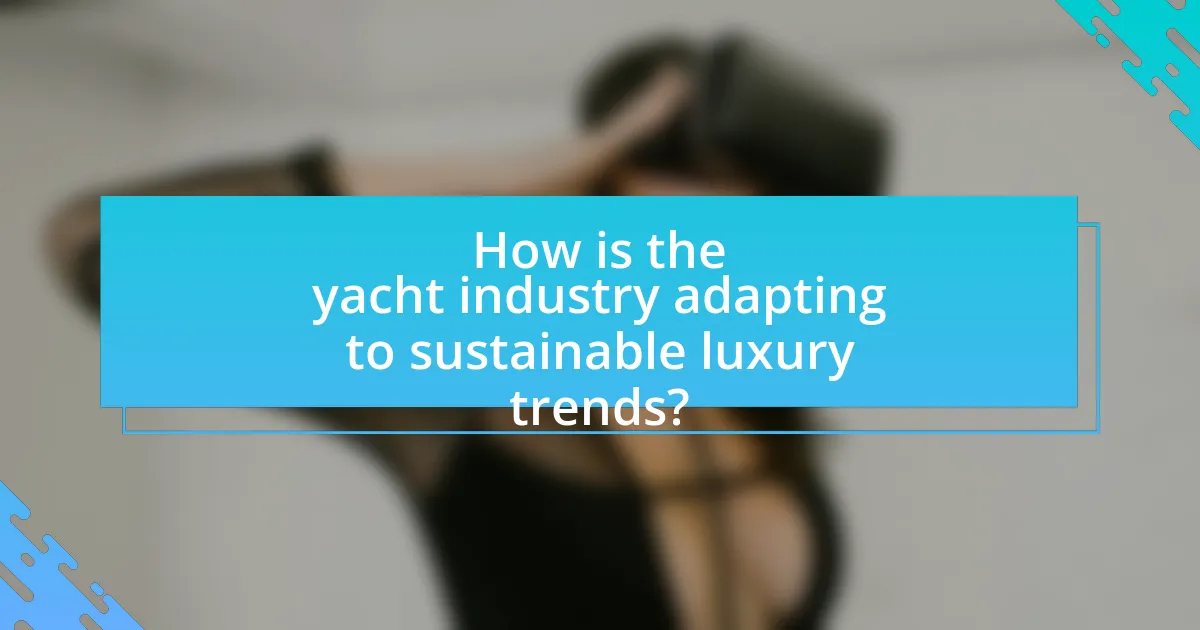
How is the yacht industry adapting to sustainable luxury trends?
The yacht industry is adapting to sustainable luxury trends by integrating eco-friendly technologies and materials into yacht design and manufacturing. For instance, many manufacturers are now utilizing hybrid propulsion systems that combine traditional engines with electric power, significantly reducing fuel consumption and emissions. Additionally, the use of sustainable materials, such as recycled aluminum and responsibly sourced wood, is becoming more prevalent in yacht construction. According to a report by the International Maritime Organization, the adoption of these technologies can lead to a reduction in greenhouse gas emissions by up to 30%. Furthermore, yacht builders are increasingly focusing on energy-efficient designs, such as optimizing hull shapes for better hydrodynamics, which enhances fuel efficiency. These adaptations reflect a broader commitment within the industry to align with global sustainability goals while maintaining luxury standards.
What role do regulations play in promoting sustainable yacht manufacturing?
Regulations play a crucial role in promoting sustainable yacht manufacturing by establishing standards that manufacturers must adhere to in order to minimize environmental impact. These regulations often include requirements for the use of eco-friendly materials, energy-efficient technologies, and waste management practices. For instance, the International Maritime Organization’s MARPOL Convention sets limits on pollution from ships, compelling yacht builders to adopt cleaner technologies and practices. Compliance with such regulations not only drives innovation in sustainable materials and processes but also enhances the marketability of yachts, as consumers increasingly prefer environmentally responsible options.
How are international standards influencing eco-friendly practices?
International standards are significantly influencing eco-friendly practices by establishing benchmarks for sustainability that industries, including yacht manufacturing, must adhere to. These standards, such as ISO 14001 for environmental management systems, guide companies in implementing practices that reduce environmental impact, promote resource efficiency, and enhance sustainability. For instance, adherence to these standards can lead to the adoption of cleaner technologies and materials, which are crucial in yacht manufacturing to minimize emissions and waste. Furthermore, compliance with international standards often enhances a company’s marketability, as consumers increasingly prefer products that align with eco-friendly principles, thereby driving innovation in sustainable luxury.
What certifications are available for sustainable yachts?
Certifications available for sustainable yachts include the International Maritime Organization’s (IMO) Energy Efficiency Design Index (EEDI), which mandates energy efficiency standards for new vessels, and the RINA Green Plus certification, which assesses environmental performance and sustainability practices. Additionally, the Bureau Veritas offers the “Green Marine” certification, focusing on reducing environmental impacts in the marine industry. These certifications validate a yacht’s commitment to sustainability through rigorous assessments and compliance with international standards.
What challenges do manufacturers face in implementing sustainable practices?
Manufacturers face significant challenges in implementing sustainable practices, primarily due to high initial costs and technological limitations. The transition to eco-friendly materials and processes often requires substantial investment in new technologies and training, which can deter manufacturers from making the shift. For instance, a study by the Ellen MacArthur Foundation highlights that the upfront costs of sustainable materials can be 10-30% higher than traditional options, impacting profit margins. Additionally, the lack of established supply chains for sustainable materials complicates sourcing, making it difficult for manufacturers to consistently obtain the necessary resources. These factors collectively hinder the widespread adoption of sustainable practices in the yacht manufacturing industry.
How do cost considerations affect the adoption of eco-friendly innovations?
Cost considerations significantly influence the adoption of eco-friendly innovations in yacht manufacturing by determining the financial feasibility of implementing sustainable technologies. High initial investment costs for eco-friendly materials and technologies often deter manufacturers from adopting these innovations, as they may prioritize short-term profitability over long-term sustainability. For instance, a study by the International Council on Clean Transportation found that while electric propulsion systems can reduce operational costs over time, the upfront costs can be prohibitive for many yacht builders. Additionally, the perceived risk of adopting unproven technologies can further complicate decision-making, leading manufacturers to favor traditional methods that may be less environmentally friendly but are more familiar and financially secure.
What are the technological barriers to sustainable yacht manufacturing?
The technological barriers to sustainable yacht manufacturing include limitations in material availability, high production costs, and insufficient energy-efficient technologies. The yacht manufacturing industry often relies on traditional materials like fiberglass and metals, which are not environmentally friendly. Additionally, the production processes for sustainable materials, such as bio-composites, can be more expensive and complex, making them less appealing to manufacturers. Furthermore, the lack of advanced energy-efficient technologies, such as hybrid propulsion systems, hinders the transition to more sustainable practices. These barriers collectively impede the widespread adoption of eco-friendly innovations in yacht manufacturing.
What are the best practices for consumers interested in sustainable luxury yachts?
Consumers interested in sustainable luxury yachts should prioritize purchasing vessels made from eco-friendly materials and equipped with energy-efficient technologies. These yachts often utilize sustainable resources such as recycled aluminum and responsibly sourced wood, which significantly reduce environmental impact. Additionally, opting for yachts with hybrid or fully electric propulsion systems can minimize fuel consumption and emissions, aligning with sustainability goals. Research indicates that the global market for eco-friendly yachts is growing, with a 20% increase in demand for electric and hybrid models reported by the International Council on Clean Transportation in 2022. Furthermore, consumers should consider the yacht’s lifecycle, including its recyclability and the environmental practices of the manufacturer, ensuring that the entire production process adheres to sustainable standards.
How can buyers assess the sustainability of a yacht before purchase?
Buyers can assess the sustainability of a yacht before purchase by examining its materials, energy efficiency, and waste management systems. Evaluating the yacht’s construction materials, such as sustainably sourced wood or recycled metals, indicates environmental responsibility. Additionally, buyers should consider the yacht’s energy efficiency features, including hybrid propulsion systems or solar panels, which reduce fuel consumption and emissions. Furthermore, reviewing the yacht’s waste management systems, such as onboard treatment facilities for sewage and recycling capabilities, demonstrates a commitment to minimizing environmental impact. These factors collectively provide a comprehensive understanding of the yacht’s sustainability credentials.
What tips can help consumers make eco-friendly choices in yacht ownership?
Consumers can make eco-friendly choices in yacht ownership by selecting energy-efficient vessels, utilizing sustainable materials, and adopting green technologies. Energy-efficient yachts often feature hybrid or electric propulsion systems, which significantly reduce fuel consumption and emissions. Additionally, choosing yachts constructed from sustainable materials, such as recycled aluminum or responsibly sourced wood, minimizes environmental impact. Implementing green technologies, such as solar panels and water purification systems, further enhances sustainability by reducing reliance on non-renewable resources and improving onboard resource management. These practices align with the growing trend in the yacht industry towards sustainability, as evidenced by the increasing number of manufacturers offering eco-friendly options.












